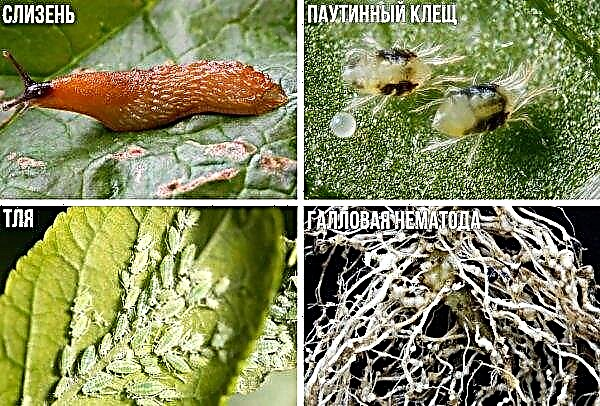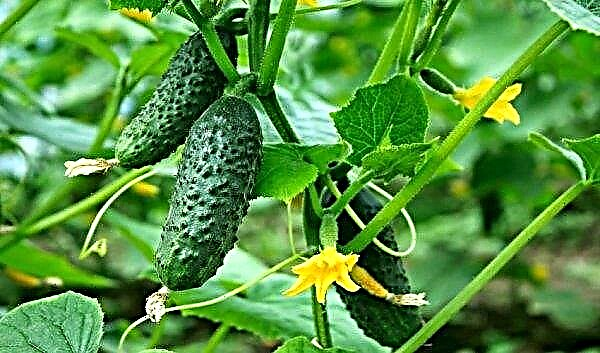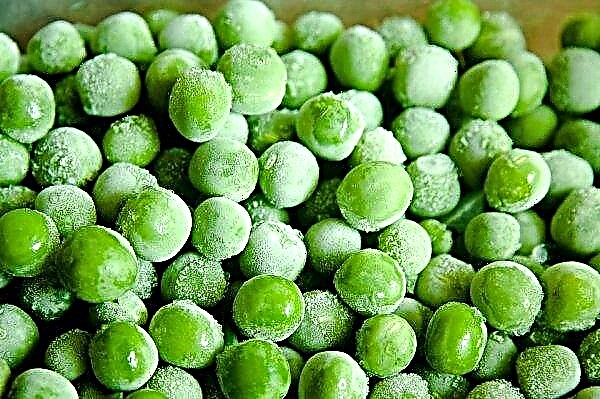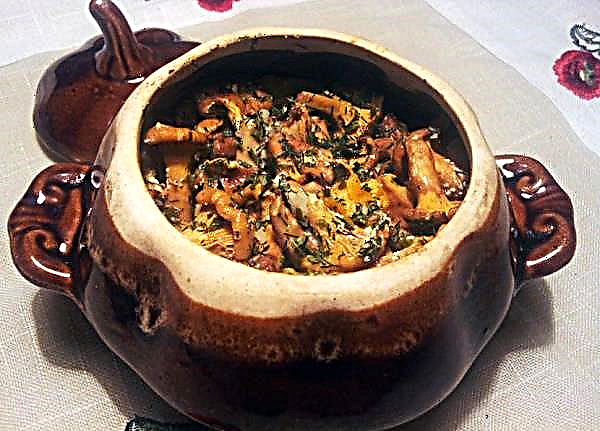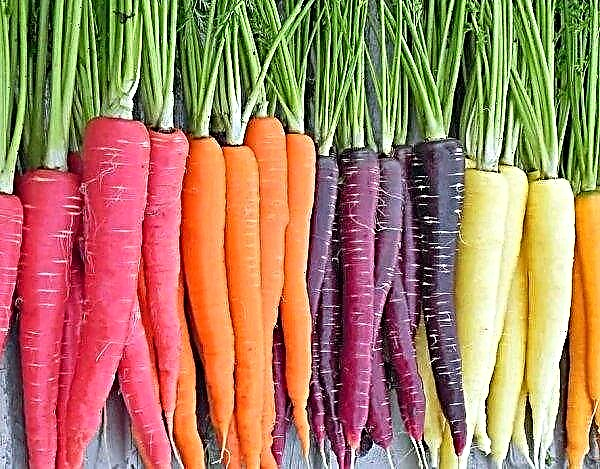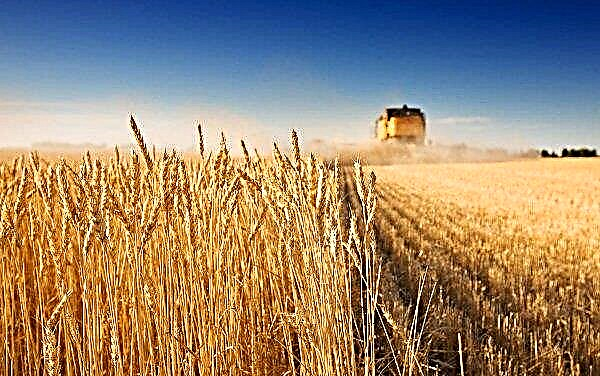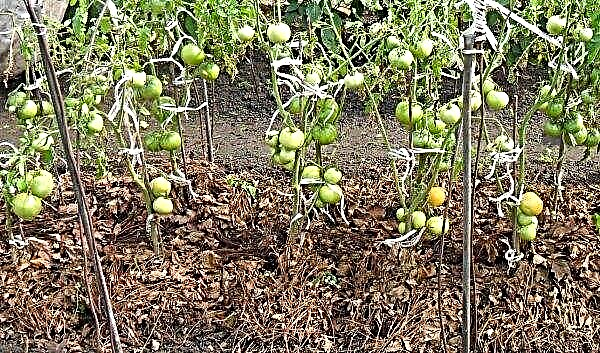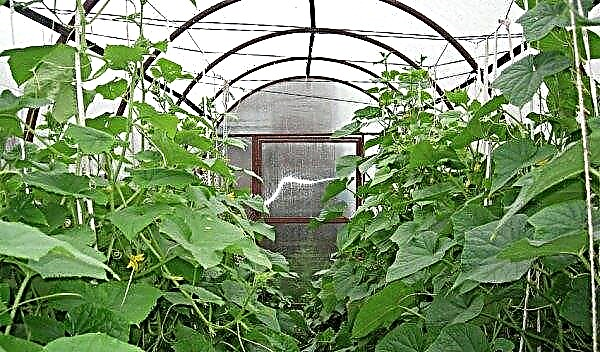The Kesha variety is one of those grape varieties that have already won the love and recognition of many gardeners. However, not everyone knows how to plant it correctly on their site and what crop can be expected in the future, so we suggest that you familiarize yourself with the key rules for caring for it at home.
Selection history
The mid-early table variety Kesha appeared by crossing varieties Vostorg and Frumoasa Albe. The author of the new grape were Russian breeders from VNIIViV im. Potapenko. Other, less popular names of this variety are Delight Superior and FV-6-5.
Did you know? Among the grape varieties, both classic blue fruits and red, pink, yellow and white, with completely different shades, are distinguished. However, it is in dark berries that contains the largest number of useful substances, in particular those that prevent the formation of oncological processes.
Description and characteristics of grapes
The Kesha variety has many attractive advantages, but before studying them, it is worthwhile to thoroughly familiarize yourself with the main characteristics: the external data of the bush and berries, the taste properties and characteristics of possible varietal variations.
Appearance
Mentioned variety refers to vigorous species, with high yields. With good care, grapes will always be large and snug, with a cylindrical-conical shape. The length of the ripened brush is about 18-24 cm, with a weight of 550-1000 g. The berries are large (about 30 × 27 mm), sweet and fleshy. Sugar content in the range of 19-24%. The weight of one berry is not more than 14 g. On average, the Kesha variety ripens 100–115 days.
The Kesha variety includes two subspecies, which, depending on the speed of occurrence, are designated as Kesha 1 and Kesha 2. At the same time, each of them is also known by other names.
Usage and Purpose
Kesha is a table grape, which means that it is better to use it fresh or preserve it with whole berries. Wine from it is unlikely to succeed, since the juice is poorly separated from the pulp, but you can still make healthy summer smoothies. Is it worth it to make other drinks from the fruits - everyone decides for himself, but this grape is great for creating delicious and fragrant baked goods.
Advantages and disadvantages
The advantages of growing Kesha variety are much greater than the disadvantages, but in any case it is important to consider all the features of this elite grape.
- Strengths in this case are:
- excellent taste characteristics;
- friendly ripening of fruits;
- attractive appearance, which is largely the merit of large and mature brushes;
- high fertility indicators of young bushes (fruits appear on 80% of shoots, therefore, in order to avoid thickening of plants, one has to deal with thinning by hand).
As for the minuses of cultivating Kesha, it is worth noting that winter hardiness is not high enough (in the northern regions of Russia and Ukraine you can not do without winter shelter), as well as the need to regularly remove a large number of stepsons that thicken the planting.
How to choose the right seedlings when buying
In order not to miscalculate with the purchased seedling, it is best to buy it not in the market, but in a special nursery with a good reputation. Employees of garden centers will always be able to pick you a strong and completely healthy seedling, which you can verify the quality of just by inspecting the planting material.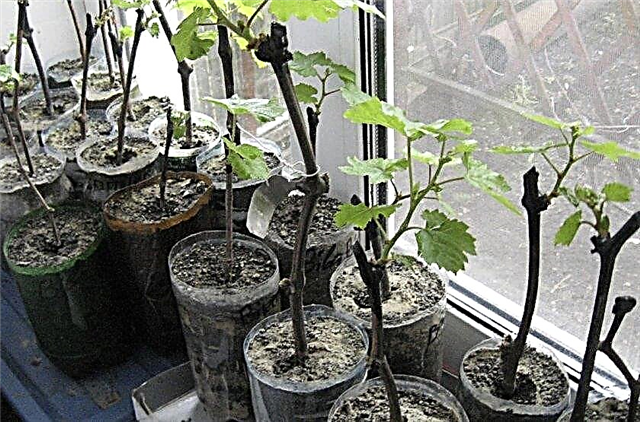 The roots of Kesha grapes should not be overdried, and with a small cut of the skin of a suitable specimen, a bright middle will necessarily appear from the inside. The leaves and vine of the selected plant should also not have any damage or signs of disease, otherwise there is a high probability that it will not take root in a new place or immediately begin to hurt, which will negatively affect the quality of the future crop.
The roots of Kesha grapes should not be overdried, and with a small cut of the skin of a suitable specimen, a bright middle will necessarily appear from the inside. The leaves and vine of the selected plant should also not have any damage or signs of disease, otherwise there is a high probability that it will not take root in a new place or immediately begin to hurt, which will negatively affect the quality of the future crop.
A day before the alleged grape planting, the roots of the roots are slightly trimmed from the seedling and placed in a solution of a growth stimulator, which in the future will provide good rooting in a new place.
Important! Do not buy seedlings in closed containers that do not allow to evaluate the real state of the rhizome. Sometimes even a healthy looking plant can suffer from the initial stage of root rot, which will only develop in the future.
Landing Features
The preparation for planting a seedling, like the process itself, always has certain characteristics, depending on the selected variety. Kesha in this regard is not very demanding, but at the same time, the gardener is required to choose the right site and perform the required technical actions.
Site selection and preparation
The optimal area for placing the described grapes will be a well-lit area, but without constant exposure to direct sunlight (they can leave burns on the leaves). Planting of seedlings or cuttings usually occurs in late April or early May, when the soil is warm enough. In this case, already in September, new shoots will appear on the young plant, and next year the grapes will give the first fruits. When preparing the site for planting a seedling, the soil from the autumn is cleared of plant debris and dug shovels on a bayonet so that in the spring, two weeks before the procedure, only dig out the planting pits and fertilize them. If moisture accumulation is often observed in the area, it is useful to put broken brick or expanded clay on the bottom of the hole, which will serve as a good drainage layer.
When preparing the site for planting a seedling, the soil from the autumn is cleared of plant debris and dug shovels on a bayonet so that in the spring, two weeks before the procedure, only dig out the planting pits and fertilize them. If moisture accumulation is often observed in the area, it is useful to put broken brick or expanded clay on the bottom of the hole, which will serve as a good drainage layer.
Important! To ensure good pollination of grapes on the site, it is worth planting not only the Kesha variety, but also other varieties of grapes with bisexual flowers.
Landing technology
The planting process of Kesha variety is quite standard and involves the following actions:
- 2-3 weeks prior to planting, dig a hole 80 × 80 cm in size and cover it 1/3 with soil mixed with a small amount of rotted humus.
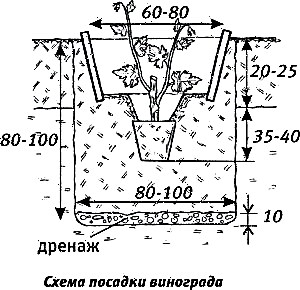 If it is planned to plant several plants at once, the second hole should be dug no closer than 1 m from the previous one (the distance between the rows in this case should be at least 50 cm).
If it is planned to plant several plants at once, the second hole should be dug no closer than 1 m from the previous one (the distance between the rows in this case should be at least 50 cm). - On the day of planting, add a clean soil mixture to the pit and, having placed the seedling rhizome on it, carefully fill it with the remaining soil. The depth of grape planting is determined based on the height of the root neck: together with the place of grafting, it should remain above the soil surface.
- After planting a young plant, it is abundantly watered (the liquid must be brought into the hole organized around the seedling at a distance of 30 cm from the trunk) and tied to a support. The amount of water used at a time can be 20–25 liters.
Cultivation and care
When cultivating the Kesha variety, the key points in caring for it will be the organization of competent watering, the selection of appropriate fertilizers, pruning of the vine and loosening of the soil while removing weeds.
Watering and fertilizing
Unlike many other grape varieties, the Kesha variety does not need a lot of moisture, therefore, with moderate rainfall, it is watered only after removing the winter shelter, before flowering and during the fruit set season. For each bush, an average of 15–20 liters of standing, relatively warm water is consumed. In order not to make mistakes in calculations and not to overfill the bush (this can make the fruits too watery), you can dig a small drainage hole next to it, into which excess water will drain.
In order not to make mistakes in calculations and not to overfill the bush (this can make the fruits too watery), you can dig a small drainage hole next to it, into which excess water will drain.
In a dry period, the frequency of irrigation will have to be increased, and here it is already better to focus on the state of the upper soil layer: it should not dry out by more than 5 cm.From fertilizers, Kesha grapes will be equally useful as organic compounds (for example, rotted manure), and mineral mixtures, including phosphorus and potassium. With nitrogen-containing products you need to be very careful, since a large concentration of this substance is harmful to Kesha grapes.
Pruning
Sanitary pruning of Kesha grapes is performed in the same mode as for other varieties, that is, before buds appear on the vine. All parts frozen over the winter will have to be removed, and in the future it will be necessary to control the bush thickening, removing unnecessary lateral barren shoots and wilted leaves from it. A new kidney will grow in place of the cut antenna, without a kidney, but time will tell how fruitful it will be. If, during the repeated formation of the antennae, new inflorescences still do not appear on it, you will have to cut off the entire branch on which it is formed so that new shoots appear from the place of pruning over time (at least two out of five should be fruiting). Of course, non-fruiting shoots are subsequently removed.
A new kidney will grow in place of the cut antenna, without a kidney, but time will tell how fruitful it will be. If, during the repeated formation of the antennae, new inflorescences still do not appear on it, you will have to cut off the entire branch on which it is formed so that new shoots appear from the place of pruning over time (at least two out of five should be fruiting). Of course, non-fruiting shoots are subsequently removed.
With an excessive amount of leafy shoots, sunlight and a sufficient amount of air do not get inside the bush, which means that the formed clusters will not be able to develop normally, which will necessarily affect their size.
Did you know? Grapes are one of the oldest cultivated plants on our planet, mentions of which were found in the Babylonian cuneiform writing, in the Homeric Iliad and Odyssey, which were worked on according to approximate estimates of archaeologists in the 9th – 8th centuries. BC e.
Soil weeding
An overgrowth of weeds can lead to thickened grapes, so you need to fight it immediately as soon as it sprouts from under the ground. Weeding can be done while loosening the soil, which will be appropriate after the next watering. It is much easier to remove weeds from a moistened substrate, and they are easily stretched along with the root. It is undesirable to use chemicals in the fight against them, because in any case there is a likelihood of chemicals entering the vine. On average, weeding the Kesha variety will not have to spend more than one hour in two weeks, but this is only if you do not start your site.
On average, weeding the Kesha variety will not have to spend more than one hour in two weeks, but this is only if you do not start your site.
Important! You can protect the root zone of grapes from weeds and excessive evaporation of moisture by mulching the area with rotten manure. In this case, the layer of such mulch should not exceed 3 cm.
Breeding methods
Among the actual methods of propagation of grapes of the described variety, only two of the most suitable options are distinguished - planting cuttings and grafting an old plant, which will help to renew it. Planting material, separated from the mother bush, easily roots in closed soil, after which the grown seedling can be planted at a constant place of growth, as described above.
On average, it will be possible to get the first crop with this method of propagating the Kesha variety no sooner than in 3-4 years, so many gardeners prefer to simply update the old bush by grafting. Moreover, this procedure can be performed during the entire vegetative period of the plant, which is also an additional advantage. The grape grafting process consists of the following steps:
The grape grafting process consists of the following steps:
- Slicing of an annual cut from a healthy mother plant (performed wedge-shaped) and its treatment with a root stimulant (for example, “Humate”). In winter grafting, it is advisable to additionally cover the stalk with melted paraffin (after applying the material, the planting material must be immersed in cold water). This will protect it from exposure to low temperatures.
- Trimming and grouting from the splinter of the bush of the bush (the place of grafting should be smooth and even).
- Performing a small split on the shoot, the dimensions of which will correspond to the size of the shank (a shaft with a too large split is no longer suitable for further use).
- Placing the cuttings in a split and fastening the fracture site with fabric twine (it is better not to use artificial materials, since they do not decompose).
- The application of wet clay to the rootstock and its covering with a soil layer, which should prevent excessive evaporation of moisture (without it, the process of merging a new cuttings and an old plant will be impossible).
 On a large stem, you can perform several vaccinations at once, but in any case, the plant needs to be supported with a support, and in several places at once. On this, the vaccination process can be considered completed and the gardener can only observe the success of further growth.
On a large stem, you can perform several vaccinations at once, but in any case, the plant needs to be supported with a support, and in several places at once. On this, the vaccination process can be considered completed and the gardener can only observe the success of further growth.Shelter for the winter
The Kesha grape variety is a cold-resistant plant that can withstand frosts down to -23 ° C. However, in some cases, this level of frost resistance is not enough, and in order to avoid freezing of the vine and the appearance of ice on it, it is better to shelter the shoots in a timely manner. It is advisable to carry out this procedure shortly after the autumn pruning of the vine, simply removing the shoots from the support and securing them to the soil itself.
At the end of November, all branches should be covered with foliage or other dried branches, and in addition - stretch agrofibre or plastic film with holes for air circulation.
Important! The vine should not be covered with vapors, otherwise the drops that appear on frosty days will quickly turn into ice.
Diseases and Pests
The described variety is characterized by a fairly high resistance to diseases and pests, however, the probability of infection cannot be completely ruled out. Regularly inspect the vine and vine leaves for signs of powdery mildew, gray rot and ticks, which are the most common enemies of the Kesha variety.
Powdery mildew it affects the green part of the grape and spreads very quickly throughout the bush. The main symptom of a problem is a slightly yellowish, even tuberous coating on the leaves, sometimes presented as shapeless spots. In dealing with it, they usually use a solution of iron sulfate (300 g per 1 bucket of water), as well as special fungicidal preparations: for example, Strobi and Mikal, diluted in water according to the instructions on the package. Grape processing is preferably carried out in calm weather, previously protecting the skin and respiratory tract from chemical exposure. Gray rot - a fungal disease that develops actively with high levels of humidity. The main symptom of grape damage is the presence of brown-gray spots on all parts of the bush, over time, damaged leaves and shoots fall off. Dead parts must be removed from the site, otherwise the spores of the fungus will again fall on the plant. To prevent the development of gray rot, the plant is sprayed with a solution of the Folpan preparation, and the fungicides Topsin M and Rohrval Flo are suitable for the active stage of the disease.
Gray rot - a fungal disease that develops actively with high levels of humidity. The main symptom of grape damage is the presence of brown-gray spots on all parts of the bush, over time, damaged leaves and shoots fall off. Dead parts must be removed from the site, otherwise the spores of the fungus will again fall on the plant. To prevent the development of gray rot, the plant is sprayed with a solution of the Folpan preparation, and the fungicides Topsin M and Rohrval Flo are suitable for the active stage of the disease.
- brown spots covered with a slight pubescence (felt mite);
- light spots coated with yellow plaque (spider mite);
- yellow spots with a hole in the middle (leaf mite).
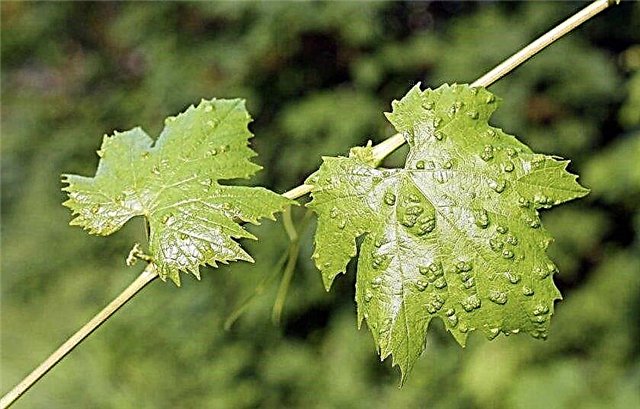 At the initial stage of the lesion, the pest can be removed manually by wiping the leaf plate with a soap solution, however, if the problem has become widespread, then the use of insecticides can not be dispensed with. The compositions of Aktar and Vermitek will be effective in this regard, but when working with them it is important to observe utmost care, as they are very toxic.A more gentle means of combating ticks will be Karbofos, in addition to which you can use decoctions and infusions of wormwood, potato tops and tobacco.
At the initial stage of the lesion, the pest can be removed manually by wiping the leaf plate with a soap solution, however, if the problem has become widespread, then the use of insecticides can not be dispensed with. The compositions of Aktar and Vermitek will be effective in this regard, but when working with them it is important to observe utmost care, as they are very toxic.A more gentle means of combating ticks will be Karbofos, in addition to which you can use decoctions and infusions of wormwood, potato tops and tobacco.As a prevention of diseases and pests, it is advisable to treat the plant with a 1% Bordeaux mixture twice a season, and also monitor the removal of excess fluid from the bush.
Thus, the Kesha variety is not very demanding for care, and with moderate attention it will always delight you with large and tasty grapes. The reproduction of this grape will not be difficult.

 If it is planned to plant several plants at once, the second hole should be dug no closer than 1 m from the previous one (the distance between the rows in this case should be at least 50 cm).
If it is planned to plant several plants at once, the second hole should be dug no closer than 1 m from the previous one (the distance between the rows in this case should be at least 50 cm).